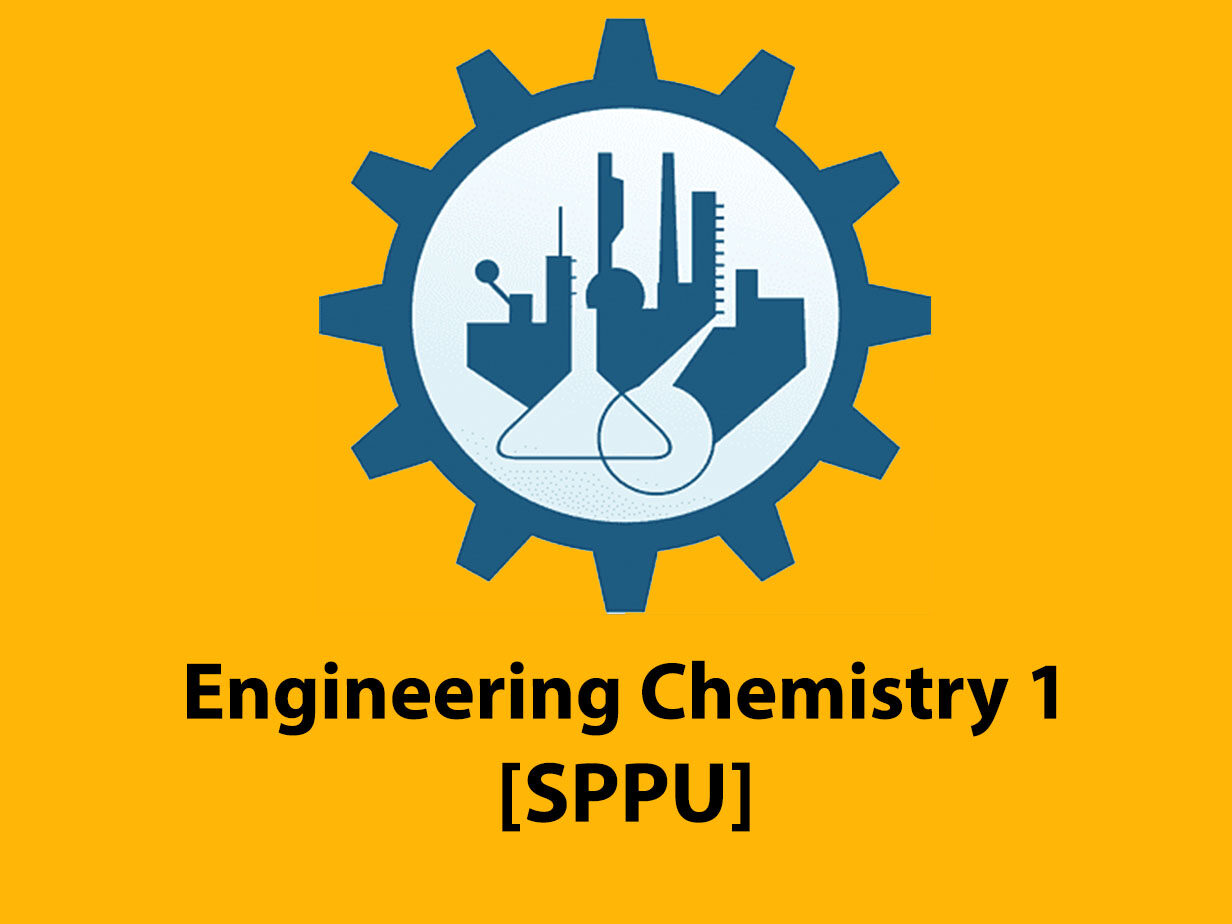Engineering Chemistry 1 [SPPU]
Free

-
INDEX
- BOD and COD With Numerical
- Ion Exchange Process with Numerical
- Normal Hardness Numerical 1
- Zeolite [part 2]
- Zeolite [part 1]
- Numerical on atom economy
- Anti Knocking in Fuels
- Knocking in Fuels
- Gasoline & its Refining Steps in Fuels
- Cracking of Petroleum 01
- Cracking of Petroleum 02
- Cracking of Petroleum 03
- Refining of Petroleum
- Introduction to Fuels
- Bio-diesel in Fuels
- Alloys Introduction
- Liquid Fuels
- Cetane Number
- Ultimate Analysis Numerical 01
- Ultimate Analysis Numerical 02
- Ultimate Analysis Numerical 03
- Numerical Combustion in Fuels
- HCV or GCV and LCV or NCV in Fuels
- How to Pass Applied Chemistry
- Corrosion Part 1
- Corrosion Part 2
- Corrosion Part 3
- Dry Corrosion Part 1
- Dry Corrosion Part 2
- Wet Corrosion Part 01
- Wet Corrosion Part 02 with difference
- Different Types of Corrosion Part 01
- Different Types of Corrosion Part 02
- Different Types of Corrosion Part 03
- Factors Affecting Corrosion
- prevention and control corrosion part 1
- prevention and control corrosion part 2
- prevention and control corrosion part 3
- prevention and control corrosion part 4
- Green Chemistry Introduction
Engineering Chemistry 1 [SPPU]
. Objectives of the subject Engineering Chemistry-I are The concepts developed in this course will aid in quantification as well as understand the applications of several concepts in Chemistry that have been introduced at the 10 + 2 levels in schools.
Outcomes of the subject Engineering Chemistry-I are that Learners will be able to explain the concept of microscopic chemistry in terms of atomic and molecular orbital theory and relate it to diatomic molecules. Describe the concept of aromaticity and interpret it with relation to specific aromatic systems. Illustrate the knowledge of various types of intermolecular forces and relate it to real gases. Interpret various phase transformations using thermodynamics. llustrate the knowledge of polymers, fabrication methods, conducting polymers in various industrial fields. Analyze the quality of water and suggest suitable methods of treatment.
Engineering Chemistry program integrates advanced knowledge of organic chemistry, analytical chemistry, and electrochemistry into the design curriculum. By studying this subject, students can gain experience in the design of large-scale chemical manufacturing plants. An atom is the smallest unit of ordinary matter that forms a chemical element. Every solid, liquid, gas, and plasma is composed of neutral or ionized atoms. Atoms are extremely small, typically around 100 picometers across. They are so small that accurately predicting their behavior using classical physics as if they were tennis balls, for example—is not possible due to quantum effects. Chemical Engineers “invent economic ways of using materials and energy”. Chemical engineers use chemistry and engineering to turn raw materials into usable products, like medicine, petrochemicals, large-scale plastics, industrial setting, etc. They are also including waste management and research. Aromatic compounds are those chemical compounds (most commonly organic) that contain one or more rings with pi electrons delocalized all the way around them. In contrast to compounds that exhibit aromaticity, aliphatic compounds lack this delocalization. The term “aromatic” was assigned before the physical mechanism determining aromaticity was discovered, and referred simply to the fact that many such compounds have a sweet or pleasant odour; however, not all aromatic compounds have a sweet odour, and not all compounds with a sweet odour are aromatic. Aromatic hydrocarbons, or arenes, are aromatic organic compounds containing solely carbon and hydrogen atoms. The configuration of six carbon atoms in aromatic compounds is called a “benzene ring”, after the simple aromatic compound benzene, or a phenyl group when part of a larger compound.
Module Corrosion consist of the following subtopics Introduction: Types of Corrosion- (I) Dry or Chemical Corrosion-i) Due to oxygen ii) Due to other gases (II) Wet or Electrochemical corrosion- Mechanism i) Evolution of hydrogen type ii) Absorption of oxygen. Types of Electrochemical Corrosion- Galvanic cell corrosion, Concentration cell corrosion (differential aeration), Pitting corrosion, Intergranular corrosion, Stress corrosion. Factors affecting the rate of corrosion- Nature of metal, the position of the metal in galvanic series, potential difference, overvoltage, the relative area of anodic and cathodic parts, purity of the metal, nature of the corrosion product, temperature, moisture, influence of pH, the concentration of the electrolytes. Methods to decrease the rate of corrosion Material selection, Proper designing, Use of inhibitors, Cathodic protection- i) Sacrificial anodic protection ii) Impressed current method, Anodic protection method, Metallic coatings- hot dipping- galvanizing and tinning, metal cladding, metal spraying, Electroplating, Cementation. Organic coatings – Paints (only constituents and their functions). Module Alloys consist of the following subtopics Introduction, purpose of making alloys, Ferrous alloys, plain carbon steel, heat-resisting steels, stainless steels (corrosion-resistant steels), the effect of the alloying element- Ni, Cr, Co, Mn, Mo, W, and V; Non-Ferrous alloys- Composition, properties and uses of- Alloys of Aluminium- i) Duralumin ii) Magnalium. Alloys of Cu- (I) Brasses-i) Commercial brass ii) German silver, (II) Bronzes- i) Gunmetal ii) High phosphorous bronze. Alloys of Pb- i) Wood’s metal ii) Tinmann’s solder. Powder Metallurgy- Introduction, (1)Methods of powder metal formation- i) Mechanical pulverization ii) Atomization iii) Chemical reduction iv) Electrolytic process v) Decomposition (2) Mixing and blending. (3) Sintering (4) Compacting- i) Cold pressing ii) Powder injection molding (iii) Hot compaction. Applications of powder metallurgy. Shape Memory Alloys- Definition, properties, and Uses.
Corrosion is a natural process that converts a refined metal into a more chemically stable form such as oxide, hydroxide, or sulfide. It is the gradual destruction of materials (usually a metal) by chemical and/or electrochemical reaction with their environment. Corrosion engineering is the field dedicated to controlling and preventing corrosion. In the most common use of the word, this means electrochemical oxidation of metal in reaction with an oxidant such as oxygen or sulfates. Rusting, the formation of iron oxides is a well-known example of electrochemical corrosion. This type of damage typically produces oxide(s) or salt(s) of the original metal and results in distinctive orange coloration. Corrosion can also occur in materials other than metals, such as ceramics or polymers, although in this context, the term “degradation” is more common. Corrosion degrades the useful properties of materials and structures including strength, appearance, and permeability to liquids and gases. A fuel is any material that can be made to react with other substances so that it releases energy as heat energy or to be used for work. The concept was originally applied solely to those materials capable of releasing chemical energy but has since also been applied to other sources of heat energy such as nuclear energy (via nuclear fission and nuclear fusion). Module Fuels consist of the following subtopics Definition, classification of fuels-solid, liquid and gaseous. Calorific value- Definition, Gross or Higher calorific value & Net or lower calorific value, units of heat (no conversions), Dulong’s formula & numerical for calculations of Gross and Net calorific values. Characteristics of good fuel. Solid fuels- Analysis of coal- Proximate and Ultimate Analysis with Significance and numerical. Liquid fuels- Crude petroleum oil, its composition and classification and mining (in brief). Refining of crude oil- i) Separation of water ii) Separation of ‘S’ & iii) Fractional Distillation with diagram and composition and uses table. Cracking- Definition, Types of crackingI) Thermal cracking (i) Liquid-phase thermal cracking (ii) Vapour phase thermal cracking. II) Catalytic cracking- (i) Fixed-bed catalytic cracking (ii) Moving-bed catalytic cracking. Advantages of Catalytic cracking. Petrol- Refining of petrol, unleaded petrol (use of MTBE), Catalytic converter, Power alcohol, Knocking, Octane number, Cetane number, Antiknocking agents. Combustion- Calculations for requirement of only oxygen and air (by weight and by volume only) for given solid & gaseous fuels. Biodiesel- Method to obtain Biodiesel from vegetable oils (Trans-esterification), advantage and disadvantages of biodiesel. Fuel cell- Definition, types and applications. Module Composite Materials consist of the following subtopics Introduction, Constitution- i) Matrix phase ii) Dispersed phase. Characteristic properties of composite materials. Classification- (A) Particle – reinforced composites- i) Large – particle reinforced composites ii) Dispersion – strengthened composites. (B) Fiber – reinforced composites- i) Continuous – aligned ii) Discontinuous – aligned (short)- (a) aligned (b) randomly oriented (C) Structural Composites- i) Laminates (ii) Sandwich Panels. Module Green Chemistry consist of the following subtopics Introduction, Twelve Principles of Green chemistry, numerical on atom economy, Conventional and green synthesis of Adipic acid, Indigo, Ibuprofen and Carbaryl. Green solvents (water,supercritical CO2) and products from natural materials.
Prepare For Your Placements: https://lastmomenttuitions.com/courses/placement-preparation/
![]()
/ Youtube Channel: https://www.youtube.com/channel/UCGFNZxMqKLsqWERX_N2f08Q
Follow For Latest Updates, Study Tips & More Content!
Course Features
- Lectures 40
- Quizzes 0
- Duration 50 hours
- Skill level All levels
- Language Hindi
- Students 146
- Certificate No
- Assessments Yes


![Thumbnails-1 Engineering Chemistry [RTU]](https://lastmomenttuitions.com/wp-content/uploads/2019/08/Thumbnails-1-450x450.jpg)